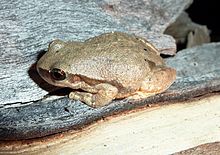Desert tree frog
| Desert tree frog | |
|---|---|

| |
| Scientific classification | |
| Domain: | Eukaryota |
| Kingdom: | Animalia |
| Phylum: | Chordata |
| Class: | Amphibia |
| Order: | Anura |
| Family: | Hylidae |
| Genus: | Litoria |
| Species: | L. rubella
|
| Binomial name | |
| Litoria rubella Gray, 1842
| |

| |
| Desert tree frog distribution | |
The desert tree frog (Litoria rubella), or little red tree frog, is a species of tree frog native to Australia, southern New Guinea, and Timor.[2] It is one of Australia's most widely distributed frogs, inhabiting northern Australia, including desert regions and much of temperate eastern Australia. It is one of the few Australian tree frogs to inhabit arid, tropical, and temperate climates.
Description
[edit]
It is rotund, with a small, flat head. It has short arms and strong, short legs. Adults are 28–43 mm (1.1–1.7 in) in snout-vent length.[3] Its ventral surface is white, and the dorsal surface ranges from light grey to dark red and has small black flecks.[3] Adult specimens from Cooktown, Queensland, often show a pronounced metallic sheen on the dorsal surface, ranging in colour from bronze to gold.[3] A dark band runs from the snout, across the eye, and along the flanks of the frog. The throats of males in breeding season are a dark grey colour.[3] The groin is lemon-yellow, and the tympanum is visible. Baby frogs have an almost transparent abdomen, allowing a clear view of their abdominal organs.
Ecology and behaviour
[edit]The wide distribution and the large range of habitats it inhabits create a large variation in breeding habits. Populations that live in temperate or tropical zones breed annually during the wet season or summer. However, the populations in desert regions will breed whenever rain occurs. Tadpole development is dependent on the temperature of the water. Small amounts of water heat to higher temperatures, which triggers the tadpoles to develop faster; some develop in just 14 days.
Unlike most desert frogs, it does not burrow to avoid heat and desiccation. It will seek out shelter under rocks, trees, or leaf litter. They are commonly found around human dwellings where water is available and can be found in sinks, toilets or drain pipes. Compared to other desert frogs of a similar size, they have a relatively low rate of evaporative water loss, and do not dry out as quickly as expected under hot and dry conditions. Their low rate of evaporative water loss can partly be attributed to adopting a water-conserving posture, where frogs tuck their limbs close to their body and close off ventral skin from the outside environment.[4] One study found that frog species like desert tree frogs that use water-conserving postures tended to have a higher resistance to evaporative water loss.[5] Desert tree frogs can also change their color from dark brown to bright white, which serves to increase solar reflectance off the skin and decreases their heat intake, and, unlike most amphibians, when exposed to dry air they will change color regardless of previous background color.[5]
References
[edit]- ^ Djoko Iskandar, Mumpuni, Jean-Marc Hero, Dale Roberts, Paul Horner, Richard Retallick, Ed Meyer, John Clarke, Stephen Richards, Fred Parker (2004). "Litoria rubella". IUCN Red List of Threatened Species. 2004: e.T41110A10400269. doi:10.2305/IUCN.UK.2004.RLTS.T41110A10400269.en. Retrieved 19 November 2021.
{{cite journal}}: CS1 maint: multiple names: authors list (link) - ^ Frost, Darrel R. (2015). "Litoria rubella (Gray, 1842)". Amphibian Species of the World: an Online Reference. Version 6.0. American Museum of Natural History. Retrieved 18 December 2015.
- ^ a b c d Barker, J.; Grigg, G.; Tyler, M. (1995). A field guide to Australian Frogs. Surrey Beatty. ISBN 978-0-949324-61-0.
- ^ "EVAPORATIVE WATER LOSS AND COLOUR CHANGE IN THE AUSTRALIAN DESERT TREE FROG LITORIA RUBELLA (AMPHIBIA HYLIDAE) | Western Australian Museum". museum.wa.gov.au. Retrieved 2023-12-02.
- ^ a b Young, Jeanne E.; Christian, Keith A.; Donnellan, Stephen; Tracy, Christopher R.; Parry, David (September 2005). "Comparative Analysis of Cutaneous Evaporative Water Loss in Frogs Demonstrates Correlation with Ecological Habits". Physiological and Biochemical Zoology. 78 (5): 847–856. doi:10.1086/432152. ISSN 1522-2152. PMID 16052451. S2CID 41549175.
- IUCN Red List least concern species
- Litoria
- Fauna of Timor
- Amphibians of Queensland
- Amphibians of New South Wales
- Amphibians of South Australia
- Amphibians of Western Australia
- Amphibians of the Northern Territory
- Amphibians of Indonesia
- Amphibians of Papua New Guinea
- Amphibians described in 1842
- Taxa named by John Edward Gray
- Frogs of Australia

